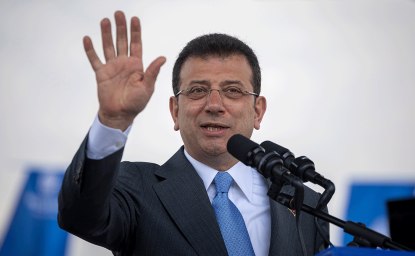Big scale political crises occur in Ukraine approximately once in a decade, with each next crisis more devastating than the previous one. However, if the crises of 1994 and 2004 resulted in a change of power, the crisis of 2013 so far has not been resolved.
Yanukovych, as opposed to Kuchma, is not facing the problem of either staying in power, nor looking for successor.The crisis of 2013, as opposed to the crisis of 2004, burst out not at the end, but in the middle of Yanukovych’s first administration. Despite the confrontation inside his own group (the “Family,” with A. Rakhmetov on one side, and D. Firtash and S. Lyovochkin on the other) and mass protests, Yanukovych is still regarded as a fully legitimate “boss” by the political elite. The president’s entourage obviously fails to see either serious internal threats (revolution) or external threats (sanctions) that would push it towards the opposition. The immaturity of the elite, both in power and in the opposition, has been manifested more than once in the history of independent Ukraine, but while the elite in power incurred losses in the international arena and distrust inside the country for its amateurish attitude, the opposition has been discredited in the past and incapable of seizing power.
The citizens’ capacity for going out into the streets both in 2013 and in 2004 was not taken into account neither by sociologists nor by the opposition nor the ruling elite. However, in 2004 the protests were prepared in advance by the opposition and youth organizations, while in 2013 the first outburst of protests was spontaneous. Had the government not used force on the night of November 30-December 1, no one knows whether Maidan would have mobilized such a huge number of people and endured for so long. Mobilization was triggered by the “dashed expectations,” i.e. non-material factors, which makes one reconsider the traditional views of the factors of mobilization.
Three factors constituted important components of the Orange Revolution’s success: а) a split inside President’s Kuchma circle, especially after Mayor Omelchenko and various oligarchs joined the opposition; b) the refusal of some of the commanders of the SBU (Security Service of Ukraine), army, and militia to use force to stifle the protests; and c) the split of the pro-presidential majority in Parliament. In 2013, the opposition failed to offer the terms on which oligarchs, law enforcement officials, and a portion of the Party of Regions fraction in Parliament, as well as non-fractional deputies dependent on them, could join them. Lack of one opposition leader and the threat of penalty imposed by the “boss” contributed to maintaining of integrity of three key “pillars of power.” Both Maidan and the opposition failed to provide a charismatic leader, capable of providing adequate guarantees of safety for oligarchs, law enforcement, and power-supporting deputies that would allow them to join the opposition. On the other hand, intimidation of the Party of Regions fraction deputies, reported by its former members, delayed its split. In other words, the price of joining the opposition seemed higher than the price of leaving President Yanukovych’s “patronage network.” Besides, Yanukovych has at his disposal a party which dominates Parliament and controls the majority of the oblast’ and raion councils, while Kuchma did not have his own party in parliament and was supported by several oligarchic clans. The split in President Kuchma’s entourage and not sending law-enforcement bodies to quell the protests became the impetus for the Supreme Rada deputies to declare the second round of presidential elections null and void, with the ensuing reformation of the majority, opening the way to political compromise. Maintaining the Party of Region fraction’s integrity, and the oligarchs’ and law enforcement’s loyalty, provide Yanukovych with a solid base to hold onto his power.
Finally, elections is the third condition. On the one hand, “stolen” elections facilitate mobilization, while on the other, they can help in overcoming the crisis. The “stolen” elections incited mass protest actions in 2004, while the decision of the Supreme Court on another vote in the second round of the presidential elections, to which both candidates agreed, gave the opportunity to resolve the crisis peacefully. In 2013, M. Azarov’s decision to suspend the signing of the Association Agreement with EU incited the protests. This decision as well as the attempt to disband Maidan by force provoked the crisis, which could not have been resolved institutionally due to the absence of elections and total dependence of the judicial power on the presidential administration. If the institutional mechanisms of dealing with public discontent are not available in society, then this discontent as well as the arising conflicts can become explosive. Despite all attempts at provocations, the Maidan protests were absolutely peaceful. If the power tries again to disband Maidan by force or to penalize Maidan activists with reprisals, it is possible that the peaceful movement will go underground and become radicalized.
This analysis leads us to a number of conclusions:
1. Mass mobilization is a necessary, but not sufficient precondition for a change in power. A comparison of the 2004 and 2013 developments in Ukraine demonstrates that the organizational potential of power turned out stronger than “the strength of the people.” Yanukovych, as opposed to Kuchma, is not facing the problem of either seeking formal grounds to stay in power, nor looking for his successor. In the eyes of the West, Yanukovych remains the legitimately elected president, and in the eyes of his minions – a fully legal “patron.” Anticipating the reaction of the oligarchs, law enforcement, split of the Party of Regions fraction, and having involved Putin in the game, Yanukovych managed to curb both internal and external tension, thus securing his own position, at least until 2015.
2. Euromaidan of 2013 is somewhat similar to the events of 2001–2002, known as “Ukraine without Kuchma”. Although the context of the protests is significantly different, there are at least two commonalities. The first is that both waves of protests were aimed at changing power. The second common feature is that in both cases they failed, due to the fact that institutional mechanisms, and, specifically, elections, were missing. Considering the cyclical nature of political changes in post-soviet territory, we can expect a change in power, but not necessarily a change of regime in 2015.
3. For a long time the West has been rather mild in its dealings with the Ukrainian elite and quite indifferent or openly cynical with respect to Ukrainian citizens. This approach resulted in the collapse of Eastern partnership policy. If the USA and the EU safeguard liberal values consistently, then the West should be severe with the representatives of an authoritarian regime and mild towards the average citizens.
4. Maintaining the current political elite or allowing for only insignificant changes will confirm that the authorities hear neither their citizens nor their own entourage, trying to stifle their voices instead of putting an end to the internal tension between the “Family” and the oligarchs. The institutional demands formulated by Maidan – the restitution of the 2004 Constitution, discharge of political prisoners, and the observance of rule of law – in fact amount to dismantling the super-presidential model and returning to a separation of powers which existed in Ukraine between 2006 and 2010.
5. Altogether these facts testify to the fact that the crisis of 2013 is not resolved. The set of problems that accumulated in Ukraine over the previous years, like a tightly wound spring, will unwind at the first opportunity. The decision on joining the Customs Union or the presidential elections of 2015 are the most likely factors to trigger such an unwinding.





